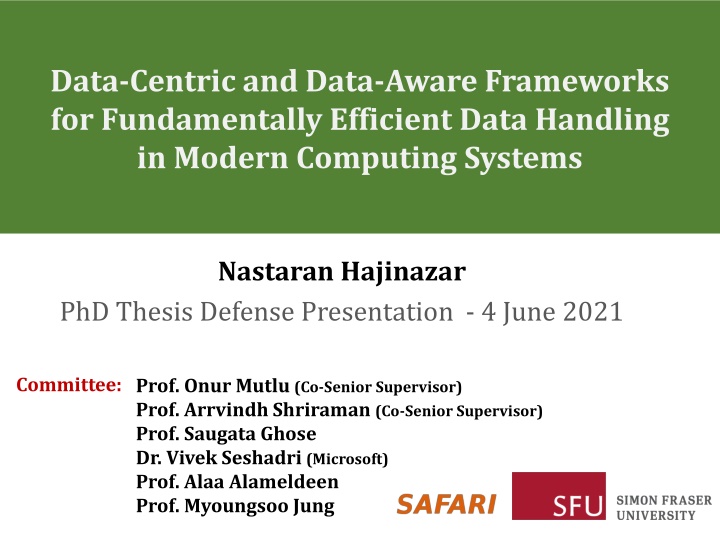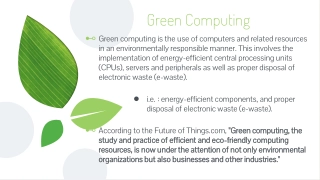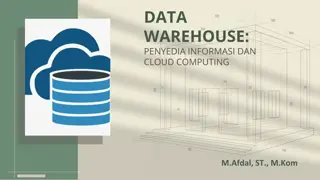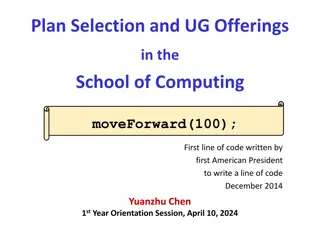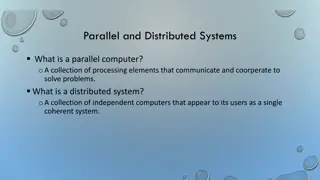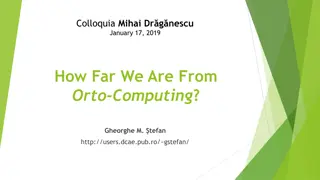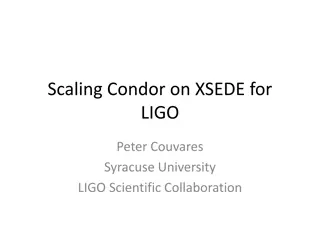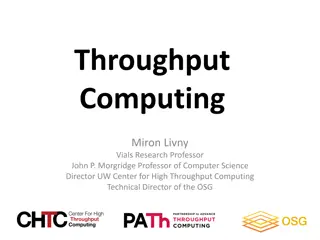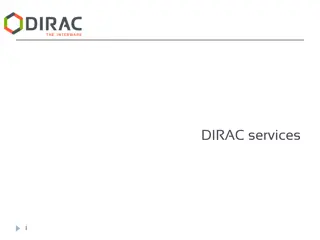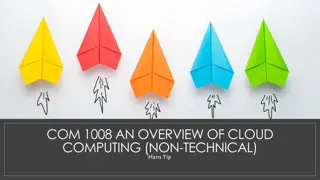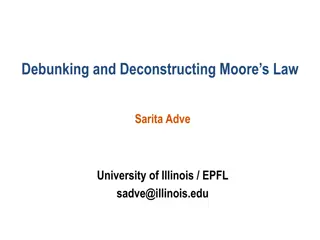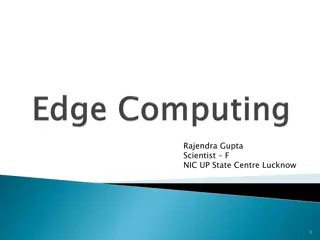Efficient Data Handling in Modern Computing Systems
There is a significant increase in data processed by modern computing systems, necessitating efficient data handling. This thesis defense presentation explores data-centric and data-aware frameworks for fundamentally improving data handling. The focus is on addressing the challenges posed by the overwhelming processor-centric design of current computing architectures.
Download Presentation

Please find below an Image/Link to download the presentation.
The content on the website is provided AS IS for your information and personal use only. It may not be sold, licensed, or shared on other websites without obtaining consent from the author.If you encounter any issues during the download, it is possible that the publisher has removed the file from their server.
You are allowed to download the files provided on this website for personal or commercial use, subject to the condition that they are used lawfully. All files are the property of their respective owners.
The content on the website is provided AS IS for your information and personal use only. It may not be sold, licensed, or shared on other websites without obtaining consent from the author.
E N D
Presentation Transcript
Data-Centric and Data-Aware Frameworks for Fundamentally Efficient Data Handling in Modern Computing Systems Nastaran Hajinazar PhD Thesis Defense Presentation - 4 June 2021 Committee: Prof. Onur Mutlu (Co-Senior Supervisor) Prof. Arrvindh Shriraman (Co-Senior Supervisor) Prof. Saugata Ghose Dr. Vivek Seshadri (Microsoft) Prof. Alaa Alameldeen Prof. Myoungsoo Jung
Outline Motivation Computing Architectures Today Processor-Centric Design Data-Oblivious Policies Our Approach SIMDRAM: A Data-Centric Framework VBI: A Data-Aware Framework Conclusion and Future Work 2
Outline Motivation Computing Architectures Today Processor-Centric Design Data-Oblivious Policies Our Approach SIMDRAM: A Data-Centric Framework VBI: A Data-Aware Framework Conclusion and Future Work 3
Data Is Increasing There is an explosive growth in the amount of data processed in modern computing systems Important applications and workloads of a wide range of domains are all data intensive Efficient and fast accessing, moving, and processing of large amounts of data is critical 4
Question: Do We Handle Data Well?! 5
Outline Motivation Computing Architectures Today Processor-Centric Design Data-Oblivious Policies Our Approach SIMDRAM: A Data-Centric Framework VBI: A Data-Aware Framework Conclusion and Future Work 6
Outline Motivation Computing Architectures Today Processor-Centric Design Data-Oblivious Policies Our Approach SIMDRAM: A Data-Centric Framework VBI: A Data-Aware Framework Conclusion and Future Work 7
Computing Systems Today Are overwhelmingly processor-centric - Computation is performed only in the processor - Every piece of data needs to be transferred to the processor enable the computation. Data Movement SoC L2 L2 L1 CPU CPU CPU L1 DRAM L3 L2 L2 L1 L1 CPU 8
Processor-Centric Design Implications High data movement volume - Energy overhead - Performance overhead Computation is bottlenecked by data movement 9
Outline Motivation Computing Architectures Today Processor-Centric Design Data-Oblivious Policies Our Approach SIMDRAM: A Data-Centric Framework VBI: A Data-Aware Framework Conclusion and Future Work 10
Higher-Level Information Is Not Visible to HW Integer Float Access Patterns Data Structures Data Type Char Software Virtual Memory Hardware 100011111 101010011 Instructions Memory Addresses Data-Oblivious Policies . . . Cache Address Translation Data Management Placement 11
Data-Oblivious Policies Implications Challenging and often not very effective - Ineffective policies - Lost performance improvement opportunities The conventional virtual memory frameworks are not efficient moving forward 12
The Problem Question: Answer: No! Do We Handle Data Well? 13
Outline Motivation Computing Architectures Today Processor-Centric Design Data-Oblivious Policies Our Approach SIMDRAM: A Data-Centric Framework VBI: A Data-Aware Framework Conclusion and Future Work 14
Overview of Our Approach Data and the efficient computation of data should be the ultimate priority of the system Data-Centric Architectures - Enable computation with minimal data movement - Compute where data resides Data-Aware Architectures - Understand what they can do with and to each piece of data - Make use of different properties of data to improve performance, efficiency, etc. 15
Thesis Statement The performance and energy efficiency of computing systems can improve significantly when handling large amounts of data by employing data-centric and data-aware architectures that can - Remove the overheads associated with data movement by processing data where it resides - Efficiently adopt the diversity in today s system configurations and memory architectures - Understand, convey, and exploit the characteristics of the data to make more intelligent memory management decisions 16
Contributions SIMDRAM: A Data-Centric Framework for Bit-Serial SIMD Processing using DRAM [ASPLOS 2021] - Efficiently implements complex operations - Flexibly supports new desired operations - Requires minimal changes to the DRAM architecture The Virtual Block Interface: A Flexible Data-Aware Alternative to the Conventional Virtual Memory Framework [ISCA 2020] - Understands, conveys, and exploits data properties - Efficiently supports diverse system configurations - Efficiently handles large amounts of data 17
Outline Motivation Computing Architectures Today Processor-Centric Design Data-Oblivious Policies Our Approach SIMDRAM: A Data-Centric Framework VBI: A Data-Aware Framework Conclusion and Future Work 18
Processing-using-Memory: Prior Works DRAM and other memory technologies that are capable of performing computation using memory Shortcomings: Support only basic operations (e.g., Boolean operations, addition) - Not widely applicable Support a limited set of operations - Lack the flexibility to support new operations Require significant changes to the DRAM - Costly (e.g., area, power) 19
Processing-using-Memory: Prior Works DRAM and other memory technologies that are capable of performing computation using memory Shortcomings: Support only basic operations (e.g., Boolean operations, addition) - Not widely applicable Need a framework that aids general adoption of PuM, by: - Efficiently implementing complex operations Support a limited set of operations - Lack the flexibility to support new operations - Providing flexibility to support new operations Require significant changes to the DRAM - Costly (e.g., area, power) 20
Goal Goal: Design a PuM framework that - Efficiently implements complex operations - Provides the flexibility to support new desired operations - Minimally changes the DRAM architecture 21
Key Idea: Provide the programming interface, the ISA, and the hardware support for: - Efficiently computing complex operations in DRAM - Providing the ability to implement arbitrary operations as required - Requiring minimal changes to DRAM architecture 23
SIMDRAM: PuM Substrate SIMDRAM framework is built around a DRAM substrate that enables two techniques: (2) Majority-based computation (1) Vertical data layout Cout= AB + ACin + BCin most significant bit (MSB) A 4-bit element size Row Decoder MAJ Cout B Cin least significant bit (LSB) Pros compared to the conventional horizontal layout: Pros compared to AND/OR/NOT- based computation: Implicit shift operation Massive parallelism Higher performance Higher throughput Lower energy consumption 24
SIMDRAM Framework: Overview User Input SIMDRAM Output Step 1: Generate MAJ logic Step 2: Generate sequence of DRAM commands Desired operation New SIMDRAM ?Program ???????? ACT/PRE ACT/PRE ACT/PRE ACT/ACT/PRE done ?Program MAJ ???????? Main memory bbop_new MAJ/NOT logic AND/OR/NOT logic ISA New SIMDRAM instruction SIMDRAM Output Instruction result in memory User Input Step 3: Execution according to Program SIMDRAM-enabled application ACT/PRE ACT/PRE ACT/PRE ACT/PRE/PRE done foo () { ACT/PRE bbop_new } ?Program Control Unit 18 Memory Controller 25
SIMDRAM Framework: Overview User Input SIMDRAM Output Step 1: Generate MAJ logic Step 2: Generate sequence of DRAM commands Desired operation New SIMDRAM ?Program ???????? ACT/PRE ACT/PRE ACT/PRE ACT/ACT/PRE done ?Program MAJ ???????? Main memory bbop_new MAJ/NOT logic AND/OR/NOT logic ISA New SIMDRAM instruction SIMDRAM Output Instruction result in memory User Input Step 3: Execution according to Program SIMDRAM-enabled application Step 1: Builds an efficient MAJ/NOT representation of a given desired operation from its AND/OR/NOT-based implementation ACT/PRE ACT/PRE ACT/PRE ACT/PRE/PRE done foo () { ACT/PRE bbop_new } ?Program Control Unit 18 Memory Controller 26
SIMDRAM Framework: Overview User Input SIMDRAM Output Step 1: Generate MAJ logic Step 2: Generate sequence of DRAM commands Desired operation New SIMDRAM ?Program ???????? ACT/PRE ACT/PRE ACT/PRE ACT/ACT/PRE done ?Program MAJ ???????? Main memory bbop_new MAJ/NOT logic AND/OR/NOT logic ISA New SIMDRAM instruction SIMDRAM Output Instruction result in memory User Input Step 3: Execution according to Program SIMDRAM-enabled application Step 2: Allocates DRAM rows to the operation s inputs and outputs Generates the sequence of DRAM commands (?Program) to execute the desired operation ACT/PRE ACT/PRE ACT/PRE ACT/PRE/PRE done foo () { ACT/PRE bbop_new } ?Program Control Unit 18 Memory Controller 27
SIMDRAM Framework: Overview User Input SIMDRAM Output Step 1: Generate MAJ logic Step 2: Generate sequence of DRAM commands Desired operation Step 3: Executes the Program to perform the operation Uses a control unit in the memory controller New SIMDRAM ?Program ???????? ACT/PRE ACT/PRE ACT/PRE ACT/ACT/PRE done ?Program MAJ ???????? Main memory bbop_new MAJ/NOT logic AND/OR/NOT logic ISA New SIMDRAM instruction SIMDRAM Output Instruction result in memory User Input Step 3: Execution according to ?Program SIMDRAM-enabled application ACT/PRE ACT/PRE ACT/PRE ACT/PRE/PRE done foo () { ACT/PRE bbop_new } ?Program Control Unit 18 Memory Controller 28
More in the Thesis Detailed reference implementation and microarchitecture of the SIMDRAM control unit 6 7 decrement is_zero Loop Counter size 1 bbop FIFO shift amount reg dst. reg src. From CPU Register Addressing Unit dst, src_1, src_2, n ?Program Scratchpad 2 bbop_op Op Op Memory +1 Register File ?Op 0 ?Op 62 ?Op 63 Proccessing FSM PC ?Op 0 ?Op 1 ?Op 62 ?Op 0 ?Op 63 / 4 branch target ?Op 0 ?Op 62 ?Op 63 ?Op 63 ?Op 16 3 To Memory Controller 5 1024 ?Program 1024 From ?Program Memory AAP/AP 29
System Integration Efficiently transposing data Programming interface Handling page faults, address translation, coherence, and interrupts Handling limited subarray size Security implications Limitations of our framework 30
System Integration Efficiently transposing data Programming interface Handling page faults, address translation, coherence, and interrupts Handling limited subarray size Security implications Limitations of our framework 31
Transposing Data SIMDRAM operates on vertically-laid-out data Other system components expect data to be laid out horizontally Challenging to share data between SIMDRAM and CPU 32
Transposition Unit Transforms the data layout from horizontal to vertical, and vice versa Last Level Cache Transposition Unit Object Tracker (OT) Horizontal Vertical Transpose Vertical Horizontal Transpose Transpose Buffer Transpose Buffer Store Unit Fetch Unit Memory Controller 33
Efficiently Transposing Data Last Level Cache Object Tracker (OT) Transposition Unit Horizontal Vertical Transpose Vertical Horizontal Transpose Transpose Buffer Low impact on the throughput of SIMDRAM operations Transpose Buffer Store Unit Fetch Unit Low area cost (0.06 mm2 in 22nm tech. node) Memory Controller 34
More in the Paper Efficiently transposing data Programming interface Handling page faults, address translation, coherence, and interrupts Handling limited subarray size Security implications Limitations of our framework 35
Key Results Evaluated on: - 16 complex in-DRAM operations - 7 commonly-used real-world applications SIMDRAM provides: 88 and 5.8 the throughput of a CPU and a high-end GPU, respectively, over 16 operations 257 and 31 the energy efficiency of a CPU and a high-end GPU, respectively, over 16 operations 21 and 2.1 the performance of a CPU an a high-end GPU, over seven real-world applications 36
Conclusion SIMDRAM: - Enables efficient computation of a flexible set and wide range of operations in a PuM massively parallel SIMD substrate - Provides the hardware, programming, and ISA support, to: Address key system integration challenges Allow programmers to define and employ new operations without hardware changes SIMDRAM is a promising PuM framework Can ease the adoption of processing-using-DRAM architectures Improve the performance and efficiency of processing- using-DRAM architectures 37
Outline Motivation Computing Architectures Today Processor-Centric Design Data-Oblivious Policies Our Approach SIMDRAM: A Data-Centric Framework VBI: A Data-Aware Framework Conclusion and Future Work 38
Prior Works Optimizations that alleviatethe overheads of the conventional virtual memory framework Shortcomings: Based on specific system or workload characteristics Are applicable to only limited problems or applications Require specialized and not necessarily compatible changes to both the OS and hardware Implementing all in a system is a daunting prospect 39
Prior Works Optimizations that alleviatethe overheads of the conventional virtual memory framework Shortcomings: Based on specific system or workload characteristics Are applicable to only limited problems or applications modern applications, by: Efficiently handling large amount of data Exploiting diverse properties of modern applications data Need a holistic solution to efficiently support Require specialized and not necessarily compatible changes to both the OS and hardware Implementing all in a system is a daunting prospect 40
Goal Design an alternative virtual memory framework that Efficiently and flexibly supports increasingly diverse data properties and system configurations that come with it Provides the key features of conventional virtual memory frameworks while eliminating its key inefficiencies when handling large amount of data 41
Key idea: Delegate physical memory allocation and address translation to dedicated hardware in the memory controller 42
VBI: Guiding Principles Size virtual address spaces appropriately for processes - Mitigates translation overheads of unnecessarily large address spaces Decouple address translation and access protection - Defers address translation until necessary to access memory - Enables the flexibility of managing them by separate structures Communicate data semantic to the hardware - Enables intelligent resource management 43
VBI: Overview Processes Processes P2 P1 . . . . . . Pn P1 P2 Pn VAS 1 VAS 2 VAS n VB 1 VB 2 VB 3 VB 4 VBI Address Space Virtual Address Space (VAS) Page Tables Memory Translation Layer managed by the OS in the memory controller Physical Memory Physical Memory conventional virtual memory VBI 44
VBI: Overview Globally-visibleVBI address space Processes . . . P1 P2 Pn VB 1 VB 2 VB 3 VB 4 VBI Address Space Memory Translation Layer in the memory controller Physical Memory 45
VBI: Overview Globally-visibleVBI address space Consists of a set of virtual blocks(VBs) of different sizes Example size classes: 4 KB, 128 KB, 4 MB, 128 MB, 4 GB, 128 GB, 4 TB, 128 TB Processes . . . P1 P2 Pn VB 1 VB 2 VB 3 VB 4 VBI Address Space Memory Translation Layer in the memory controller Physical Memory 46
VBI: Overview Globally-visibleVBI address space Consists of a set of virtual blocks(VBs) of different sizes Example size classes: 4 KB, 128 KB, 4 MB, 128 MB, 4 GB, 128 GB, 4 TB, 128 TB Processes . . . P1 P2 Pn VB 1 VB 2 VB 3 VB 4 All VBs are visible to all processes VBI Address Space Memory Translation Layer in the memory controller Physical Memory 47
VBI: Overview Globally-visibleVBI address space Consists of a set of virtual blocks(VBs) of different sizes Example size classes: 4 KB, 128 KB, 4 MB, 128 MB, 4 GB, 128 GB, 4 TB, 128 TB Processes . . . P1 P2 Pn VB 1 VB 2 VB 3 VB 4 All VBs are visible to all processes VBI Address Space Memory Translation Layer Processes map each semantically meaningful unit of information to a separate VB in the memory controller Physical Memory - e.g., a data structure, a shared library 48
Hardware-Managed Memory VBI address space provides system-wideuniqueVBI addresses Processes . . . P1 P2 Pn VBI addresses are directly used to access on-chip caches - No longer require address translation VB 1 VB 2 VB 3 VB 4 VBI Address Space Memory Translation Layer Memory management is delegated to the Memory Translation Layer (MTL) at the memory controller - Address translation - Physical memory allocation in the memory controller Physical Memory 49
OS-Managed Access Protection Processes . . . P1 P2 Pn OS controls which processes access which VBs Each process has its own permissions (read/write/execute) when attaching to a VB VB 1 VB 2 VB 3 VB 4 VBI Address Space Memory Translation Layer OS maintains a list of VBs attached to each process - Stored in a per-process table - Used during permission checks in the memory controller Physical Memory 50
Process Address Space in VBI Any process can attach to any VB Processes Processes P2 . . . . . . P1 P1 P2 Pn Pn A process' VBs define its address space - i.e., by the process actual memory needs the address space of process P1 VB 1 VAS 1 VB 2 VAS 2 VB 3 VB 4 VAS n VBI Address Space Virtual Address Space (VAS) Memory Translation Layer Page Tables in the memory controller managed by the OS First guiding principle Physical Memory Physical Memory Appropriately-sized virtual address spaces 51
